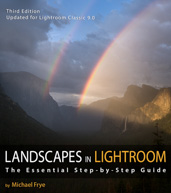In the Moment:
Michael Frye's Landscape Photography Blog
by Michael Frye | Dec 9, 2010 | Announcements, Digital Darkroom
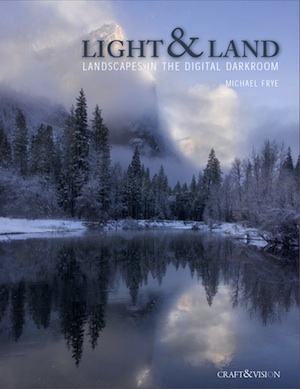
My first eBook, Light & Land: Landscapes in the Digital Darkroom, will be released next week on December 15th.
Light & Land is a natural successor to my last book, Digital Landscape Photography: In the Footsteps of Ansel Adams and the Great Masters. In the last chapter of that volume I talk about the fundamental tenets of the digital darkroom, like workflow, creating a master file, curves, and dodging and burning. In Light & Land I delve into more detail, discussing every decision about processing five different images, demonstrating the workflow from beginning to end, and, most importantly, showing you how you can use your original idea, your inspiration for pressing the shutter, to guide you as you work in the digital darkroom.
It’s published in conjunction with Craft & Vision, David duChemin’s great photography eBook site. Like all their eBooks, Light & Land will be only five dollars.
Stay tuned for more details!
by Michael Frye | Dec 7, 2010 | Announcements
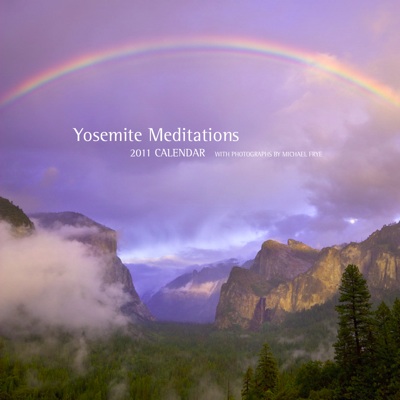 Your comments and readership have really helped this blog grow during the past year. Your passion for landscape photography, and Yosemite, has helped make this a real community. I love hearing your thoughts about a critique, your insights on the digital darkroom, or adventures trying to photograph a Yosemite snowstorm! I’ve learned as much from all of you as I hope you’ve learned from me.
Your comments and readership have really helped this blog grow during the past year. Your passion for landscape photography, and Yosemite, has helped make this a real community. I love hearing your thoughts about a critique, your insights on the digital darkroom, or adventures trying to photograph a Yosemite snowstorm! I’ve learned as much from all of you as I hope you’ve learned from me.
To show my appreciation, and perhaps make your holiday shopping a little easier, I’m making a special offer: From now until December 15th, get three calendars for the price of one—8.99. And yes, that means six for the price of two, nine for the price of three, etc. There is no limit to how many you can order, but there is a limit to how many we have left, and the offer will end before the 15th if we run out.
This 7×7 inch calendar makes a great stocking stuffer. It features 12 of my best Yosemite photographs coupled with inspiring quotations about nature and the environment. Just click “Add to Cart” to get your copies today.
Again, thank you for your time and contributions!


by Michael Frye | Dec 2, 2010 | Critiques
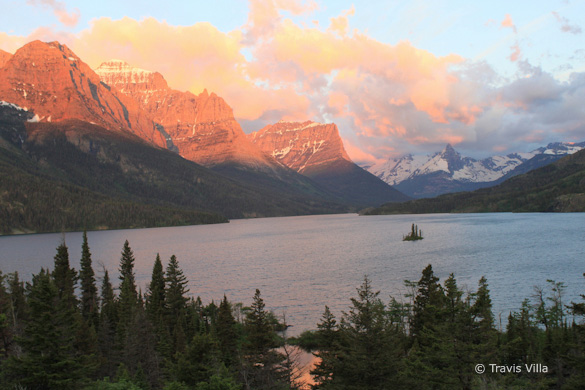
“Wild Goose Overlook” by Travis Villa
Composition and Light
This week’s photograph was made by Travis Villa in Glacier National Park, Montana. Travis wrote on Flickr, “This is one of the most spectacular sunrises I have ever seen, complemented by an already beautiful location. I felt very grateful to have a good balance (not too many or too few) of clouds in the sky that morning.”
Indeed it is a spectacular scene. Wish I had been there! The color and light are dramatic; I especially like the clouds over the pointed peak on the right half of the frame. (I’m sure someone knows the name of the peak.)
(more…)
by Michael Frye | Nov 30, 2010 | Yosemite Photo Conditions
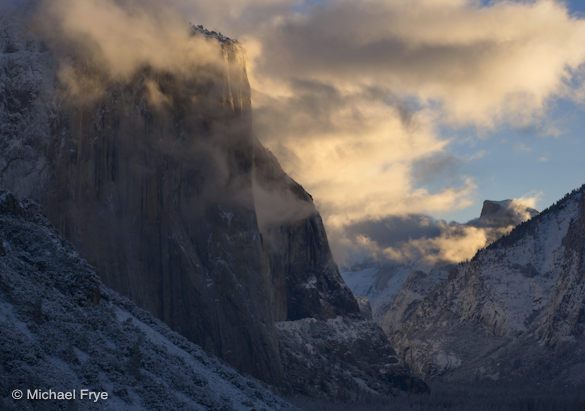
Half Dome and El Capitan, sunrise
I can’t remember seeing so much snow in November. Saturday brought another storm, and six inches of new snow to the valley floor. I went out in the blizzard Saturday afternoon to photograph snowy trees (my wife Claudia posted a photo of me in the Ahwahnee Meadow on my Facebook page). The storm cleared during the night, and Sunday was another one of those great Yosemite days—a beautiful sunrise, and fresh snow everywhere. The photo above was made from Tunnel View shortly after sunrise, and I’ve included a couple of other photos from the day below. As you can see in the last image, there is still, amazingly, some fall color in spots.
Curiously there were few other photographers in the valley. Only two other people captured the sunrise from Tunnel View—locals Evan Russell and Walter Flint. I spotted a few tripods later in the day, but was surprised there weren’t more, especially with such great conditions on a holiday weekend. Maybe no one could get reservations near the park. Or, perhaps perhaps people were actually spending time with their families instead of devoting every spare moment to photography. Imagine that! Well, with luck we’ll get many more photogenic storms this winter.
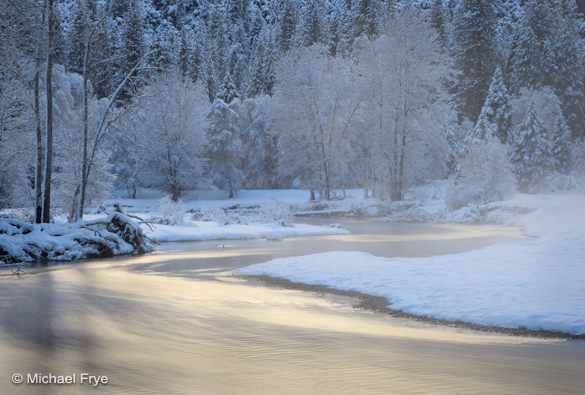
Golden reflections in the Merced River
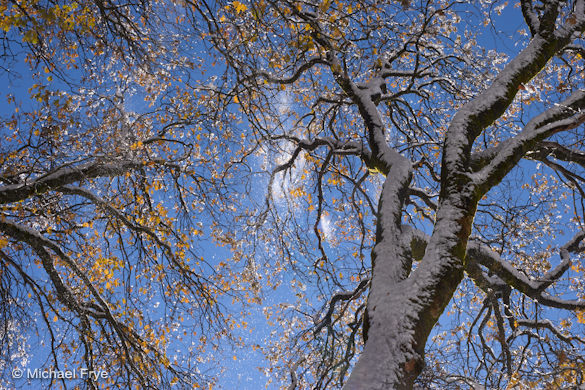
Snow falling from oaks, Ahwahnee Meadow
by Michael Frye | Nov 25, 2010 | Announcements

Peacock
I love Thanksgiving because it’s such a universal, inclusive holiday. Regardless of your religious or spiritual beliefs everyone has something to be thankful for.
As photographers, we can be thankful for the beautiful, amazing, infinitely varied world we live in, a world that provides an endless supply of great subjects to photograph.
We can also be thankful to Daguerre, or Talbot, or whoever really invented photography, for creating this wonderful medium which gives everyone an opportunity to express themselves.
I’m thankful that photography forces me to really pay attention to everything around me instead of thinking about the mundane day-to-day problems that could so easily occupy my thoughts.
I’m thankful for the inspiring work of all my fellow photographers. You never cease to surprise me!
I’m thankful that I’ve been able to live near and photograph Yosemite for over 25 years. It’s such a special place, and a great privilege to become so intimately acquainted with it.
I’m very thankful for my family, and especially for my wonderful wife who’s always been so patient with and supportive of my photography.
I’m particularly thankful for all of you—fellow photographers, blog readers, Yosemite lovers—for reading, listening, and commenting. Your participation makes writing this blog fun, and it’s great to be able to talk about my love of photography with others who share that passion.
Happy Thanksgiving!
(P.S. The critique series is taking Thanksgiving week off, but will be back next week. See you then!)
by Michael Frye | Nov 23, 2010 | Yosemite Photo Conditions
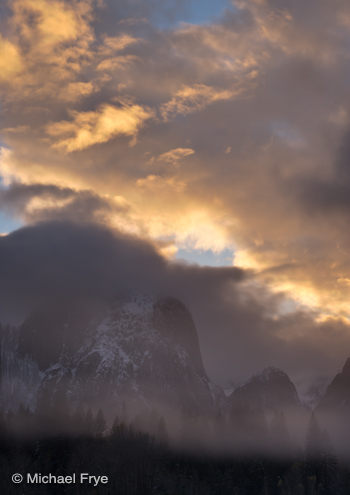 Another cold storm arrived early this morning. Rain turned to snow at my house in Mariposa about an hour ago, and the sky is full of big, fat flakes. I was in Yosemite Valley yesterday afternoon, and found about a foot of wet snow in the meadows. There could be another foot before this latest storm ends. Looks like we’ll have a white Thanksgiving!
Another cold storm arrived early this morning. Rain turned to snow at my house in Mariposa about an hour ago, and the sky is full of big, fat flakes. I was in Yosemite Valley yesterday afternoon, and found about a foot of wet snow in the meadows. There could be another foot before this latest storm ends. Looks like we’ll have a white Thanksgiving!
There’s still some nice fall color in Yosemite Valley, especially in the eastern end. The oaks adjacent to Cook’s Meadow and the Ahwahnee Meadow have retained most of their leaves, and you can find colorful dogwoods between Curry Village and the Ahwahnee Hotel.
From the comments on my previous post it sounds like many of you braved the slippery roads and made it up to Yosemite this past weekend. It was a beautiful weekend, and I bet some of you got great photos! I’m always interested in seeing what people have captured, so please feel free to include links to images in the comments.
Sunset clouds over Cathedral Rocks yesterday evening
by Michael Frye | Nov 19, 2010 | Yosemite Photo Conditions
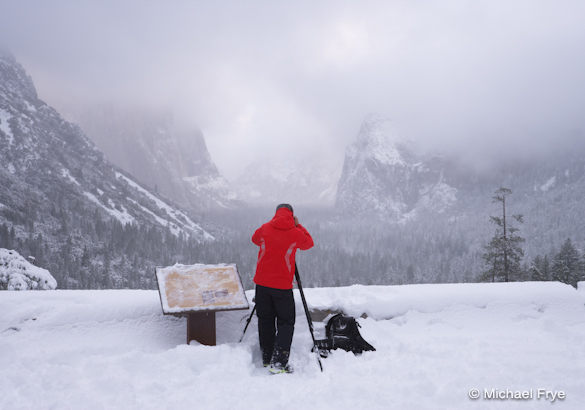
Photographer at Tunnel View on a snowy morning
When I wrote my post the other day (First Snow?) it looked like Yosemite Valley might get a few inches of snow this weekend. Now forecasters are predicting one to two feet above 4000 feet, and 8 to 12 inches above 3000 feet. There’s a big difference in driving conditions between the two scenarios. Please go only if you’re really prepared to deal with serious winter driving.
If you do still go you’ll have to bring chains of course, but make sure they actually fit! Try them on in your driveway first. It’s no fun attempting to put chains on for the first time in the middle of a blizzard, only to find that they’re too small. Also, I recommend taking Highway 140, as this is the lowest elevation route into Yosemite Valley. However it looks like even this route will have snow outside the park near Midpines on Saturday night and Sunday.
If you’re an experienced winter driver, by all means go, and have a good time! If you’re not experienced you might want to rethink your plans.
by Michael Frye | Nov 18, 2010 | Yosemite Photo Conditions
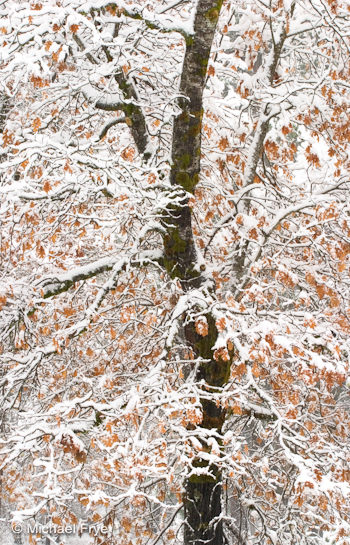
Forecasters are
expecting a cold stormto arrive this weekend. The snow level is predicted to drop to 4000 or 5000 feet on Saturday, and possibly lower on Sunday. Yosemite Valley, at 4000 feet, may get its first snow of the season.
While the fall color is past peak, the oaks have kept most of their leaves, so we could see that rare combination of snow and fall color this weekend.
In the meantime, a stretch of warm weather has allowed Tioga Pass to reopen, but it will probably close again when the forecast storm arrives around Friday night.
It could be a great weekend for photography in Yosemite, but if you come make sure you’re prepared for winter driving! Four-wheel drive is very helpful, but you’re required to carry chains even if you have four-wheel drive.
I may be in the valley on Sunday, so if you see me be sure to say hello. Good luck!
by Michael Frye | Nov 18, 2010 | Yosemite Photo Conditions

Half Dome and the Merced River, 7:41 a.m., November 8th
Even on a hot, crowded, cloudless day in August Yosemite Valley is a beautiful place. But sometimes it outdoes itself and puts on a show.
Last Monday, November 8th, was one of those days. At the peak of fall color, a rainstorm cleared during the night and left beautiful mist and clouds in its wake. As I wrote earlier, I found photographs everywhere.
I know a few other photographers who were in Yosemite Valley that day, and I thought it would be fun to see what everyone else did, and collect a portfolio of images—a portrait of Yosemite on one autumn day. So I’ve set up a Flickr group to do just that. If you were in Yosemite on November 8th, please upload some of your images so we can all see them. There are no limits to how many photographs you can include, but try to edit and show only your best work. Subject matter could be anything; the only restriction is that the photographs must have been made within the borders of Yosemite National Park on November 8th, 2010. And if you know anyone who was in Yosemite that day who might not read this blog, please send them a link and urge them to submit.
I’ve started things off by uploading 14 of my images from that day to the Flickr group. I look forward to seeing what everyone else captured!
by Michael Frye | Nov 12, 2010 | Critiques
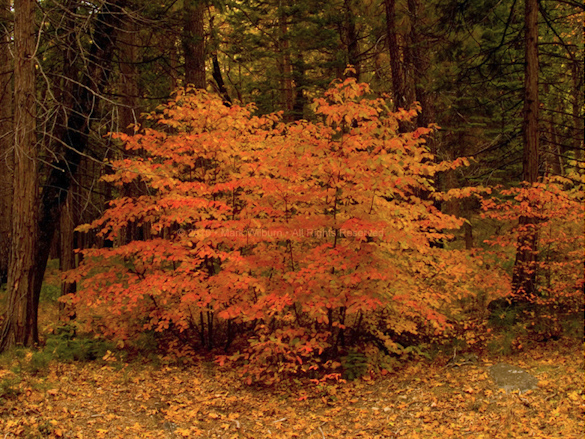
“Dogwood” by Mark Wilburn
This week’s photograph was made by Mark Wilburn in Yosemite Valley. By having his image chosen for this critique Mark will receive a free 16×20 matted print from Aspen Creek Photo. If you’d like your images considered for future critiques you can upload them to the Flickr group I created for this purpose.
Overview, Composition, and Light
This image was made just a few days ago, on November 6th, near the peak of fall color in Yosemite Valley this year. In fact I was nearby, teaching a private workshop, when Mark made this photograph. I exchanged some pleasantries with a man who said he read my blog, but I didn’t get his name. Then when I contacted Mark about using this image for a critique he told me that was him!
Anyway, I know exactly where these dogwoods are: near Gates of the Valley, also known as Valley View. The dogwoods in this area are striking right now, but not necessarily easy to photograph. It’s one thing to find a colorful subject; it’s another to build a strong composition around that color.
(more…)



















